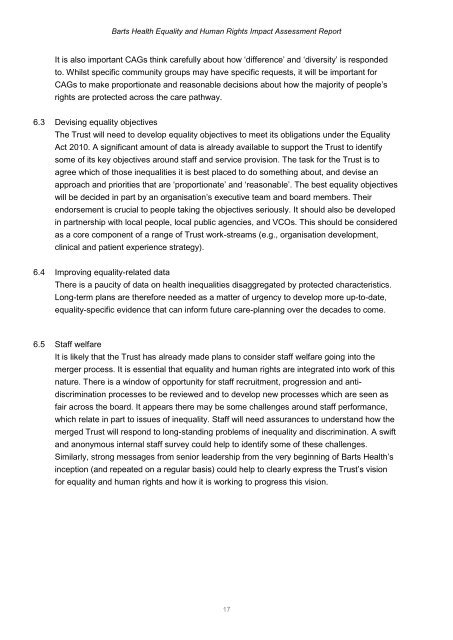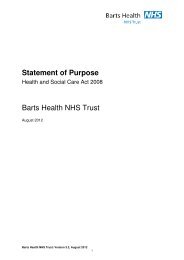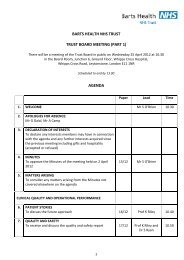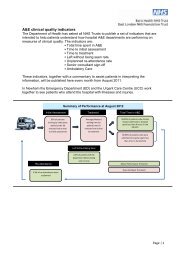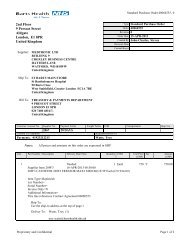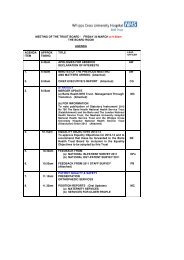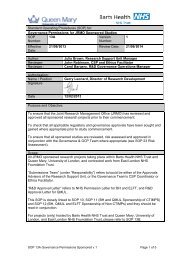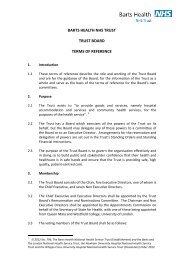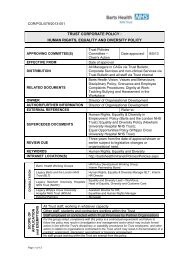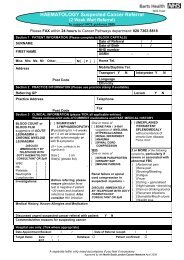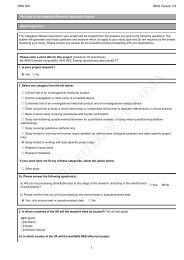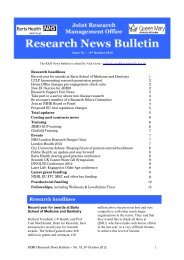Barts Health Equality and Human Rights Impact Assessment Report
Barts Health Equality and Human Rights Impact Assessment Report
Barts Health Equality and Human Rights Impact Assessment Report
- No tags were found...
You also want an ePaper? Increase the reach of your titles
YUMPU automatically turns print PDFs into web optimized ePapers that Google loves.
<strong>Barts</strong> <strong>Health</strong> <strong>Equality</strong> <strong>and</strong> <strong>Human</strong> <strong>Rights</strong> <strong>Impact</strong> <strong>Assessment</strong> <strong>Report</strong>It is also important CAGs think carefully about how ‘difference’ <strong>and</strong> ‘diversity’ is respondedto. Whilst specific community groups may have specific requests, it will be important forCAGs to make proportionate <strong>and</strong> reasonable decisions about how the majority of people’srights are protected across the care pathway.6.3 Devising equality objectivesThe Trust will need to develop equality objectives to meet its obligations under the <strong>Equality</strong>Act 2010. A significant amount of data is already available to support the Trust to identifysome of its key objectives around staff <strong>and</strong> service provision. The task for the Trust is toagree which of those inequalities it is best placed to do something about, <strong>and</strong> devise anapproach <strong>and</strong> priorities that are ‘proportionate’ <strong>and</strong> ‘reasonable’. The best equality objectiveswill be decided in part by an organisation’s executive team <strong>and</strong> board members. Theirendorsement is crucial to people taking the objectives seriously. It should also be developedin partnership with local people, local public agencies, <strong>and</strong> VCOs. This should be consideredas a core component of a range of Trust work-streams (e.g., organisation development,clinical <strong>and</strong> patient experience strategy).6.4 Improving equality-related dataThere is a paucity of data on health inequalities disaggregated by protected characteristics.Long-term plans are therefore needed as a matter of urgency to develop more up-to-date,equality-specific evidence that can inform future care-planning over the decades to come.6.5 Staff welfareIt is likely that the Trust has already made plans to consider staff welfare going into themerger process. It is essential that equality <strong>and</strong> human rights are integrated into work of thisnature. There is a window of opportunity for staff recruitment, progression <strong>and</strong> antidiscriminationprocesses to be reviewed <strong>and</strong> to develop new processes which are seen asfair across the board. It appears there may be some challenges around staff performance,which relate in part to issues of inequality. Staff will need assurances to underst<strong>and</strong> how themerged Trust will respond to long-st<strong>and</strong>ing problems of inequality <strong>and</strong> discrimination. A swift<strong>and</strong> anonymous internal staff survey could help to identify some of these challenges.Similarly, strong messages from senior leadership from the very beginning of <strong>Barts</strong> <strong>Health</strong>’sinception (<strong>and</strong> repeated on a regular basis) could help to clearly express the Trust’s visionfor equality <strong>and</strong> human rights <strong>and</strong> how it is working to progress this vision.17


